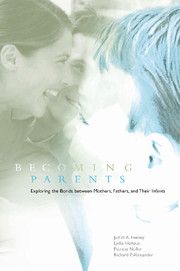Book contents
- Frontmatter
- Contents
- Preface
- 1 The Transition to Parenthood
- 2 Attachment in Childhood and Beyond
- 3 The Study
- 4 The Couples
- 5 Pregnancy and Plans for Birth
- 6 Couples' Experiences of Birth and New Parenthood
- 7 How Does New Parenthood Affect Couples?
- 8 Dealing with Depression
- 9 Men, Women, and Household Work: The Diaries
- 10 Couples' Changing Attachment Relationships
- 11 Six Months into Parenting
- 12 New Parenthood in Perspective
- Appendix A Core Questionnaires Completed by Couples
- Appendix B Summary of Sample Characteristics
- Appendix C Summary of Major Statistical Analyses
- References
- Author Index
- Subject Index
4 - The Couples
Published online by Cambridge University Press: 05 June 2012
- Frontmatter
- Contents
- Preface
- 1 The Transition to Parenthood
- 2 Attachment in Childhood and Beyond
- 3 The Study
- 4 The Couples
- 5 Pregnancy and Plans for Birth
- 6 Couples' Experiences of Birth and New Parenthood
- 7 How Does New Parenthood Affect Couples?
- 8 Dealing with Depression
- 9 Men, Women, and Household Work: The Diaries
- 10 Couples' Changing Attachment Relationships
- 11 Six Months into Parenting
- 12 New Parenthood in Perspective
- Appendix A Core Questionnaires Completed by Couples
- Appendix B Summary of Sample Characteristics
- Appendix C Summary of Major Statistical Analyses
- References
- Author Index
- Subject Index
Summary
Two different groups of married couples shared their relationship experiences with us. One group were recruited during their second trimester of pregnancy (i.e., between the 14th and 26th week). Because we were interested in following these couples throughout the rest of their pregnancy and the early months of parenthood, we will call them the transition group. The comparison group, on the other hand, consisted of couples who reported that they were not planning to have children in the near future.
DEFINING CRITERIA FOR PARTICIPATION
Both groups were restricted to couples who were in their first marriages and who had no children. These conditions were important for ensuring that the two groups of couples were as similar as possible in terms of their backgrounds (e.g., age and length of marriage) and the current state of their relationships (e.g., satisfaction with couple communication and with the relationship as a whole). This issue of the comparability of the groups is discussed in more detail later in this chapter.
Another reason for restricting the sample to first-time marriages and first-time parents was that we wanted all of the couples in the transition group to be new to the experiences of pregnancy and parenthood. That is, we were interested in their perceptions of the changes that these new experiences brought, and the adjustments that they made as a result. Our focus on first-time parenthood also recognizes the fact that bringing home a new baby is a very different experience if there are already children in the home.
- Type
- Chapter
- Information
- Becoming ParentsExploring the Bonds between Mothers, Fathers, and their Infants, pp. 60 - 71Publisher: Cambridge University PressPrint publication year: 2001



